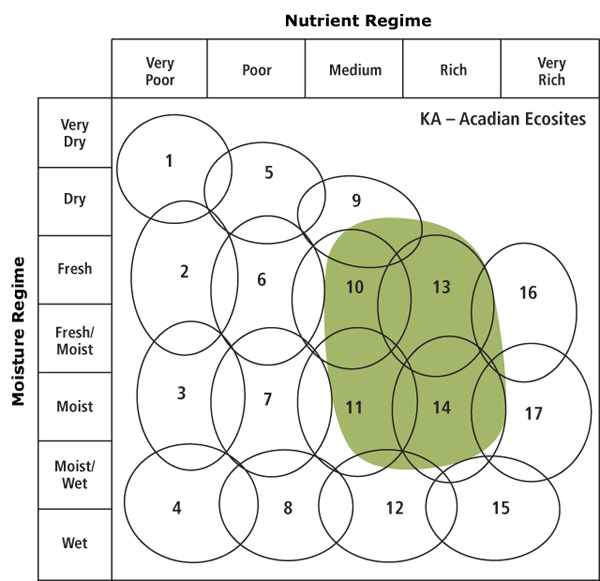
Karst Forest Group (n=8)
KA1 — Hemlock / Christmas fern – White lettuce – Wood goldenrod (n=3)
KA2 — Sugar maple / Christmas fern – Rattlesnake fern – Bulbet bladder fern (n=5)
Concept: This group is distinguished by its unique karst topography and scattered presence of vascular plants associated with karst habitat. Exposure of gypsum/limestone bedrock is needed to assign Vegetation Types (VT) to this group. Sites where karst influences are minimized by thick glacial till deposits (i.e. sites with sinkholes but no exposed bedrock) are not included. Only two broadly described VTs are currently recognized, a mature softwood/mixedwood unit and a mature hardwood unit. Early and mid-successional forest (red maple, white birch, aspen, white spruce) are known and fact sheets for these units will be developed as more data are collected. Vegetation types in this group are found only in the Acadian Ecosite group.
Vegetation:Vegetation types are closed canopy forests usually dominated by hemlock and red spruce (softwood/mixedwood unit) or sugar maple (hardwood unit), but other species are possible. The shrub layer often includes striped maple and round-leaf dogwood, with Christmas fern, wood goldenrod and white baneberry found in the herb layer. Several rare plants including yellow lady slipper, ram's head lady slipper and bulbet bladder fern are associated with this group, but are not necessarily found in every stand.
Environmental Setting: In Nova Scotia karst topography is usually associated with gypsum sites, but similar landforms have been observed over limestone and dolomite. Groundwater dissolves these soluble bedrock types producing a highly irregular surface relief called karst or “egg carton” topography containing sinkholes. Bedrock exposures are common, but surface stoniness is normally low. Most sites range from fresh to moist with medium to rich fertility. Vegetation types form small to medium size patches on the landscape. This group is found in the Northumberland Bras d'Or Lowlands (500) and Valley Central Lowlands (600) ecoregions, and in the Victoria Lowlands (220), Cape Breton Hills (310) and Inverness Lowlands (320) ecodistricts (with scattered occurrences in the Pictou Antigonish Highlands (330) ecodistrict).
Successional Dynamics:This group is associated with mid to late successional zonal VTs. Depending on site conditions and disturbance history, eventual climax forests are either softwood, mixedwood, or hardwood VTs dominated by hemlock, red spruce, balsam fir, white pine, sugar maple, yellow birch, red maple, white ash, red oak and/or beech. In the absence of harvesting, late successional stages will develop an uneven-aged structure between infrequent stand-level disturbance events. Natural disturbance agents include hurricanes (windthrow), fire, insects and subsidence.
Ecological Features: In Nova Scotia, karst occurs over soluble bedrock types such as gypsum, limestone
and dolomite. Karst landscapes are rugged and irregular with diverse surface expressions including cliffs, caves, fissures, talus, pinnacles and steep sided depressions called sinkholes. Temperate gypsum karst forests are rare in Canada and the majority of occurrences are concentrated in Nova Scotia. This presents unique conservation challenges, many of which are strongly exacerbated by gypsum mining pressures. Rare plant species (e.g. bulblet bladder fern, ram's-head lady's-slipper, shepherdia, hyssop-leaved fleabane, leatherwood and yellow lady's slipper, among other species) most commonly associated with karst are not frequent in plot data because many are only sparsely scattered across karst landscapes, and are generally more common on open cliffs and talus slopes. Karst caves provide some of the province's most important bat hibernacula. This group has good potential to support old growth composed of a variety of climax species, however stand dynamics are not well understood.
| 1a. Stands with > 25% softwood in the overstory | KA1 Hemlock / Christmas fern – White lettuce – Wood goldenrod | |
| 1b. Stands with < 25% softwood in the overstory | KA2 Sugar maple / Christmas fern – Rattlesnake fern – Bulbet bladder fern | |
